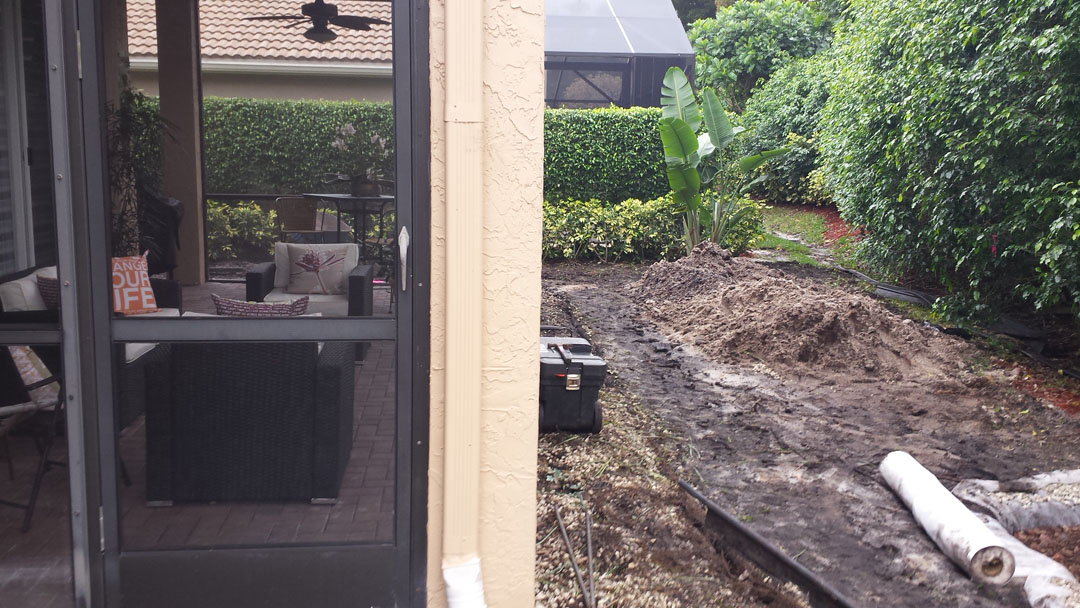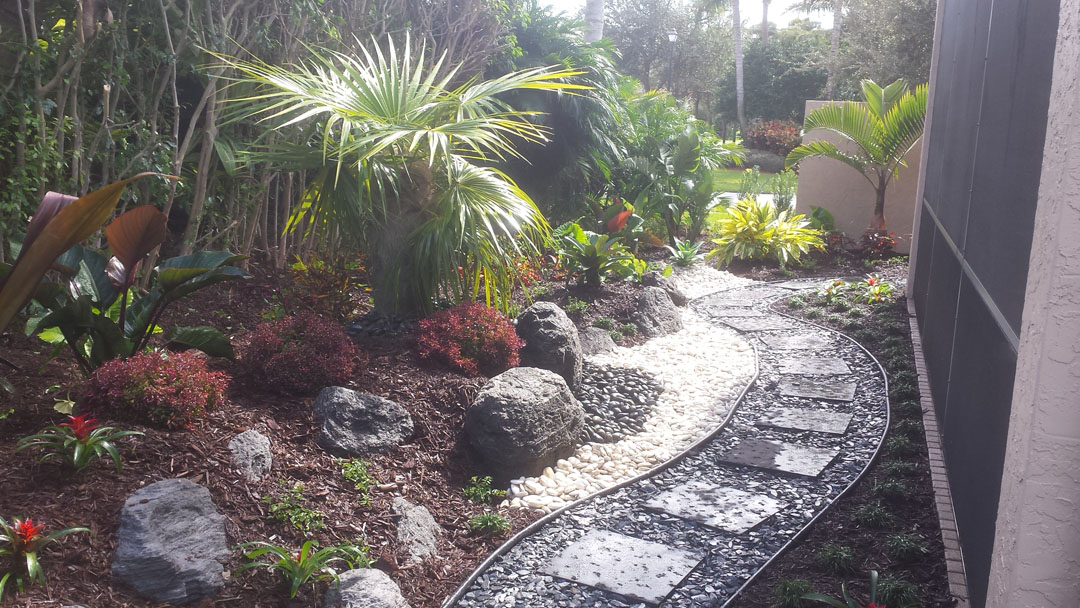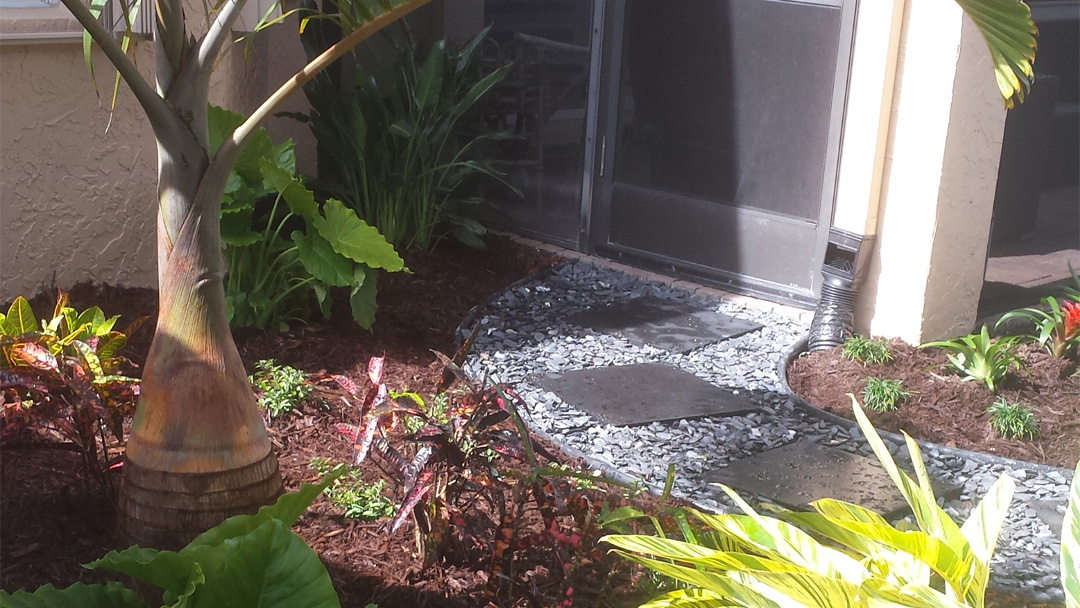Swipe to see the full images
We took a small muddy backyard with drainage problems, and we transformed it into an intimate, lush garden with a steppingstone walk path for a new landscaped vista for this residence.
In regard to scale for zero lot line properties, this property had one of the smaller of backyard properties that we come across. That point when viewing the transformation may be appreciated hopefully by many at the view of the same space in the video, years after the project was performed.
When you see the health and beauty of the landscape in the video 7 years after the installation, an important note is that these homeowners followed the instructions we provide. These homeowners took the simple measures to properly care for the landscape with watering, fertilizing, timely periodic trimmings; and the results you see speak for themselves.
The transformation immediately from the before to the after when the project was completed, the transformation from the completion to years after we think you’ll see was also worth sharing here we hope you’ll feel as well.
We note quite often to those we serve that for the customers who take the time to actually ‘read and follow’ the guidelines following their investment to have their landscape done or renovated – verses the clients that ignore the guidelines – those who follow the guidelines have significantly more healthy, longer lasting and beautiful landscapes and properties – than those who don’t. These homeowners are a testimony to that as the photos and videos of this landscape backyard makeover show.
The homeowners had two things driving their call to us for help:
- They had a drainage problem that kept the backyard too wet and muddy, plantings struggled.
- They wanted a more beautiful backyard. For a beautiful home, when looking out the back windows the view was very disappointing for them.
The first order is to deal with the problems and fix the drainage issue. We could come up with a beautiful landscape design, we could install it, the homeowners could be very happy with it; but if we were unable to fix the drainage problem, it would all be for nothing.
For this western Boynton Beach community in Palm Beach County, Florida, the soil of this property, as with many was rich and healthy, but dense and poor draining.
To make matters worse, the Hoa controlled the irrigation and was watering way too frequently; and the Hoa was not interested in changing & lessening their irrigation settings. Not only was the overwatering creating a damp property with the risks of increased mold and mildew damage to the home, it was also weakening the landscape at the same time as the over-watering created shorter root systems and weaker plants, trees, palms, lawn, everything in the landscape was weak rooted as a result.
Getting Into the Drainage Solution as First of Proposal & Project
The solution to the drainage problem at this small residence was multi – fold. Nothing drastic in our realm of work but was an eyeful for the homeowners. We tell many of our customers quite often, especially for those transformative projects; “it’s going to look a lot worse before it looks better” – and we are serious. Part of the magic… but seriously, quite often it does take a lot of effort to help some properties or to shape the earth and add or change elevations to go for a certain look we’re trying to attain for our customers.
A Drainage Easement Behind the Property that wasn’t helping
In this drainage problem there was a small easement at the rear of the property but there was not much of a decline in the level of that swale easement with the foundation of the home which was not very far from the rear of the house.
The neighborhood scale behind the properties was meant to help collect the water from all of the homes on that stretch of houses and keep that water away. However, with a level area, there was nothing keeping that water from entering the entire backyard of our clients.
When dealing with drainage issues one goal in any approach that is considerate might be good to include the thought: “not to create any new problems for any neighbors” or neighboring properties.” To fix one person’s problem and to create a new drainage problem for a neighbor is not a fixed problem in our opinion. A good drainage solution should hope to both solve a person’s or company’s drainage problem – without creating a problem for someone else in the process.
The New Soil Berm to Help with Drainage & to Add New Interest & Elevation to the Landscape
With this property, step one was to keep the neighborhood’s water easement that was behind their property from spilling water into their property during every storm. This would also lend to a more dramatic terraced landscape element which was a big part of the new desired, unique look we were to create.
The added soil was used as a decorative berm which we held and styled into place with decorative boulders that were strategically placed for both holding the soil in place and shaping the look, and artistic layout of the boulders. This would keep the storm water from behind the property in the easement – to stay in the easement. The added soil added the ingredient of an elevation which is real landscaping to us in so many projects, adding terracing and elevation changes and just more interest to the view.
The view of the backyard was not deep but the windows of the entire back of the home looked out into the plain space of a hedge and small patch of dirt and grass mixed with weeds. The overwatering from the Hoa contributed to the dollar weeds quite often.
How to get the water to leave the Property
So, the next part of the drainage problem was how to get the water during storms to leave the property and not get stuck on the house side of the new drainage / landscape berm during a storm?
The fact that we added a berm of soil, significant as it was more than two and a half feet high in some areas, for this small space can trap a lot of water, all of the water that falls on the house. That could create an even bigger problem possibly if the storm water can’t escape their property. When dealing with drainage we consider those big storms that people remember years later. Usually, a real wet week or heavy raining storm or hurricane that drops record number of inches of rain in a short period. That’s what we plan for.
If one of those storms were to hit and the water from this property was trapped from getting out, there could be larger problems than a muddy yard to look at and deal with.
This part of the drainage problem solution is basically simple to perform, very laborious sometimes and a regular drainage work procedure we have performed often. (Some people only call us for drainage problems not knowing about our landscapes)
The majority of storm water from heavy rains that creates a drainage problem for this small Zero Lot Line Property is primarily falling on the roof of this home. This is the case for many developments and homes throughout South Florida and in our immediate Palm Beach County service area. Especially with Zero Lot Line homes, there is little property on the sides, sometimes also having smaller front and backyards as well.
In these situations, the drainage solutions can even be more challenging for many because there is less space for the water to escape to. With smaller properties, less area for the water to spread and dissipate into.
Without going to much farther into the situation, we used the roof water as part of the solution. You can visit the article on our site here at: DRAINAGE PROBLEM SOLUTION: USING YOUR HOME’S GUTTERS TO HELP CLEAR OUT UNDERGROUND DRAINAGE PIPING for more information on this solution to use your home’s / building’s gutters to help with drainage problems and solutions.
With the home’s gutters tied into new underground PVC drainage piping we directed all of the home’s waters that were emptying into the backyard to be directed into the neighborhood swale collection area on the exterior of the new drainage / landscape berm we created.
In addition, we added drains on the inside of the berm, the resident’s side, to help collect any surface water and that also was expelled because of the flow of the gutter’s collected water, to the neighborhood’s swale side as well.
French Drain for Poor Draining Damp Soil Conditions
For added measure, as the “During” Photos of the project show, we installed a French Drain in the landscaped path area for helping to keep the area drier for the long term.
Our Definition of a “French Drain”. As people and companies have different definitions of what a French Drain is and what it is designed to do; our definition is a hole in the ground that has a liner fabric / cloth for lining the hole and filled with stone.
The dimensions can vary greatly depending upon the need and the scale of a problem. Typically for many residential homes, either by an air conditioner drip line that only might have a water buildup or dampness in that immediate spot, we might install a French Drain that is 1’ wide x 1’ long and 1’ deep. That French Drain hole is then lined with a cloth or similar to a Septic Liner fabric and filled with stone. Regular lawn or stone above so you can’t even tell the French drain exists.
For other spaces, similar to the project in this Transformation, the French Drain we installed in this project is a common size for damp areas being a 2’ wide x 4’ – 6’ long & 2’ deep hole. The soil that was excavated was kept on site as the photos show and was used to benefit the project in a new landscape / drainage berm. Quite often we remove and dispose of the soil. (Depending upon the project and the needs of a property.)
The Purpose of a French Drain
Our definition of the Purpose of a French Drain is that it is NOT Designed to help with Storm Water Surges or Rainstorm water that can build up.
In our definition as we described the drain above as a hole in the ground, it is Primarily intended to help reduce surface water and dampness in an immediate spot and help to dry out that immediate area where the French Drain exists.
A Prime location where a French Drain is recommended is if the ground is damp, even in the dry season of the year, if the area is usually muddy, grass can’t grow and its damp, or especially if you’re seeing the buildup of green mold or mildew on the ground.
In these cases, the French drain offers a porous cavity for the water to dissipate into. Typically, in muddy or damp spots that don’t dry well the soil is especially dense or even clay or marl like. With the dense soil removed, that cavity lined with a fabric and filled with stone it now is a basin that can easily accept water, drying out the surface above that hole. Also, the French Drain Basin can help to dry out an immediate surrounding area, the space of that influence going from mere feet to larger areas, depending on the slope and conditions of each individual property.
The reason a French Drain does not help to provide a good solution for Storm Water surges or heavy rainfalls is that similar to a bathtub, when the French Drain basin becomes filled, it cannot accept more water. Just like a bathtub that’s filled, it must empty first before it can accept more water.
For rainfall and storm surge solutions, as described above and in the referred article link, a Drainage System is one that focuses on continually helping to move water for as long as the storm or heavy rainfall lasts.
Now the Landscape!
With the drainage problem handled, which for us is a common fix which works for many properties. However, most don’t require berms, most can be handled with a drainage system itself as we outline in the article. (Article also shows photos of different projects being done as well.)
The landscape and drainage system were both designed at the same time. Irrigation heads were moved and adjusted as needed as we were making the grading, elevation and shaping changes to the property in the backyard.
The landscape was to be a lush look with points of accent and interest. Colors that the couple had expressed a desire for and accents of boulders and stone which would make a definite mark in the feel and look of the whole project.
A walkway was designed in to make the property feel a bit larger and to offer the intimate and comfortable feel of a small garden that was meant to be walked through and enjoyed. The view from inside the house and especially from the rear patio can be appreciated for how the entire ambience of the space had greatly changed. The back was not a boring view with nothing to offer but a hedge any longer, it was a space that could be enjoyed and serves as an artful backdrop in the opinion of our clients and humbly we appreciate that thought ourselves.
Old Man Palm, Bottle Palm, Feather Boulders, Steppingstones, Black Slate stone, ornamental Agaves and plantings, California Alocasias, Crotons, Ti Plants amongst a host of other plantings.
If you take a moment to look at the befores, the durings and the afters, including the video, we hope you’ll enjoy the tour of this yard and see that what began with a drainage problem challenge became a side note in the garden that was created in the landscape of this backyard makeover in a small backyard in Boynton Beach, Florida.






















